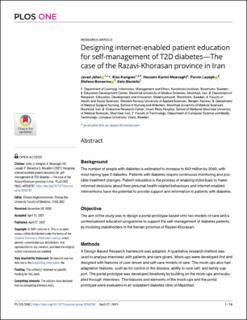| dc.contributor.author | Jafari, Javad | |
| dc.contributor.author | Karlgren, Klas | |
| dc.contributor.author | Moonaghi, Hossein Karimi | |
| dc.contributor.author | Layegh, Parvin | |
| dc.contributor.author | Bonacina, Stefano | |
| dc.contributor.author | Masiello, Italo | |
| dc.date.accessioned | 2021-10-18T08:51:52Z | |
| dc.date.available | 2021-10-18T08:51:52Z | |
| dc.date.created | 2021-04-29T22:07:58Z | |
| dc.date.issued | 2021 | |
| dc.identifier.citation | Jafari, J., Karlgren, K., Moonaghi, H. K., Layegh, P., Bonacina, S., & Masiello, I. (2021). Designing internet-enabled patient education for self-management of T2D diabetes—The case of the Razavi-Khorasan province in Iran. Plos One, 16(4), e0250781. | en_US |
| dc.identifier.issn | 1932-6203 | |
| dc.identifier.uri | https://hdl.handle.net/11250/2823596 | |
| dc.description.abstract | Background
The number of people with diabetes is estimated to increase to 642 million by 2040, with most having type 2 diabetes. Patients with diabetes require continuous monitoring and possible treatment changes. Patient education is the process of enabling individuals to make informed decisions about their personal health-related behaviours and internet-enabled interventions have the potential to provide support and information to patients with diabetes.
Objective
The aim of the study was to design a portal prototype based onto two models of care and a contextualised education programme to support the self-management of diabetes patients by involving stakeholders in the Iranian province of Razavi-Khorasan.
Methods
A Design-Based Research framework was adopted. A qualitative research method was used to analyse interviews with patients and care givers. Mock-ups were developed first and designed with features of user-driven and self-care models of care. The mock-ups also had adaptation features, such as for control of the disease, ability to cure self, and family support. The portal prototype was developed iteratively by building on the mock-ups and evaluated through interviews. The features and elements of the mock-ups and the portal prototype were evaluated in an outpatient diabetes clinic in Mashhad.
Results
Thirty-three participants were involved in the study. The evaluation of the mock-ups resulted in two themes and seven categories: 1) self-care improvement, including self-care requirements and self-management, and 2) educational usefulness, including medical information, information mode, mobility, interaction, and efficiency. The mock-up evaluation was used as a basis for designing a portal prototype. Next, the portal prototype was evaluated, and three categories emerged from the interview data: 1) user experience, 2) functionality, and 3) interactivity. Participants were not able to prioritise between the two care models. Some functionalities of the portal could benefit from the development within a cultural context to determine differences to the best way to present material.
Conclusions
A portal prototype has been designed to include two care models to support self-management and functionalities that support aspects of culture-specific diabetes self-care. This study provides guidance on developing an internet-enabled educational portal, aimed at providing support for patients in their social context. | en_US |
| dc.language.iso | eng | en_US |
| dc.publisher | PLoS | en_US |
| dc.rights | Navngivelse 4.0 Internasjonal | * |
| dc.rights.uri | http://creativecommons.org/licenses/by/4.0/deed.no | * |
| dc.title | Designing internet-enabled patient education for self-management of T2D diabetes—The case of the Razavi-Khorasan province in Iran | en_US |
| dc.type | Peer reviewed | en_US |
| dc.type | Journal article | en_US |
| dc.description.version | publishedVersion | en_US |
| dc.rights.holder | © 2021 Jafari et al. | en_US |
| dc.subject.nsi | VDP::Medisinske Fag: 700::Helsefag: 800 | en_US |
| dc.source.volume | 16 | en_US |
| dc.source.journal | PLOS ONE | en_US |
| dc.source.issue | 4 | en_US |
| dc.identifier.doi | 10.1371/journal.pone.0250781 | |
| dc.identifier.cristin | 1907337 | |
| dc.source.articlenumber | e0250781 | en_US |
| cristin.ispublished | true | |
| cristin.fulltext | original | |
| cristin.qualitycode | 1 | |

